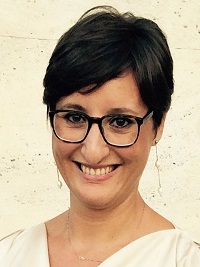Valentina Modugno

XXII Cycle - (A.A. 2006-2007)
Architecture Technology
Home Institution: University of Ferrara
Scholarship
Curriculum: Architecture (ICAR/12)
Research Topic: Sustainable architecture
Tutor DA-UNIFE: Prof. Theo Zaffagnini
Nationality: italian
Email: valentina.modugno@unife.it
Profile
Biography
Valentina Modugno, M.Sc. (Arch) in 2005 presented her dissertation in restoration within the archaeological field, and in 2010 gained her Ph.D. in Architectural Technology at the Department of Architecture of Ferrara. Her thesis obtained the recognition as Best Ph.D. Thesis of the XXII° Cycle (then published on Volume III of the Annals of the University Institute for Higher Studies, IUSS - Ferrara 1391).
Following a briefing by the Teaching Committee of the Ph.D. in Architectural Technology of the Department of Architecture of Ferrara, teaching assistant for the good doctorate of law, for the cycles XXVII ° and XXVIII ° as non-permanent staff in universities Italians, taking an active part in the organization of seminars and workshops, including international ones.
In 2010 she won a scholarship for research in the field of energy efficiency and environmental sustainability at the Research Centre Architettura>Energia the Department of Architecture of Ferrara, of which she is actually a member.
She collaborates continuously with the Department of Architecture of Ferrara, where she was Adjunct Professor of Technology of Materials, Environmental Design, Building Construction at the Department of Architecture - University of Ferrara from 2011 to 2017.
Since 2007 she has been working as a freelancer, taking part in a national and international design competition. She is the author of numerous articles and scientific publications concerning the technological innovations of products mainly in the field of materials for the architectural envelope, as well as for the recovery of the existing building heritage. Here, in particular, she developed her studies in the field of rural buildings, addressing the study of dry construction technologies, with particular attention to timber constructions.
Research skills
Architectural Technology I Building Costruction | Refurbishment | Energy efficiency | Façades | Wood architecture
Scientific activities
ORCID ID:
0000-0001-5867-8824
IRIS UNIFE ID:
rp07314
Doctoral research
LA TRASLUCENZA NELL’INVOLUCRO ARCHITETTONICO:
materiali, prestazioni e tecnologie innovative applicate alle frontiere edilizie contemporanee (TRANSLUCENCE IN THE ARCHITECTURAL ENVELOPE:
materials, performance and innovative technologies applied to contemporary architectural threshold)
Research investigates the concept of TRANSLUCENCE related to the ARCHITECTURAL ENVELOPE, through the interpretation of the new expressive tendencies of the contemporary design planning, which more and more opens up to the experimentation of innovative materials and technologic solutions. Over the past few years, many architectural planners have not only turned their attention to the creation of stimulating environments, but also focused on the design of surfaces, tactile features, of color and texture and building materials. In the current perception concept, architecture seems to shift its interpretation and essentiality limits from sensibility obtained through the features of materials, to sensibility given by artificial or natural light applied to them. The planning care seems then to achieve innovative solutions for the building structure, which is considered the baseline element of the expressive quality for architectural productions. The outline is then considered a converging point of technical and representative concepts in architectural projects, and has also a main role itself when relating with all its surroundings (streets, squares, environment, nature, other buildings and so on). In the development of research, the initial definition of architectural translucence aims to explain the status of art in this planning interpretation tendency, and to trace the possible innovative paths in the production of technological products and materials that can lead to this new potentiality. This developments are to be applied for both improvement works and/or reuse for the valorisation of existing buildings, and for new building plans. By analysing and comparing several representative and illustrative studies about the expressive potential of different materials, capable of adding translucence to structures or sections, these most innovative materials and application solutions will be hereby thoroughly elaborated. Moreover, combining the results about materials with the data obtained by comparing different representation cases, we will try to create specific guidelines for the project planners that aim to use these details.
Keywords
Technological Innovation | Translucence | Technological Boundarys | Energy Efficiency | Sustainable Architecture

